How to Speed Up Steam [2022]
Have you ever experienced how slow the Steam browser can be? Do you also struggle with slow download speeds? Or does your client just take a lot of time to load? These tips will help you get Steam up and running as fast as it can be.
More Like this: Steam Disk Write Error Fix
Steam isn’t a game itself, it is a client which contains games and provides them servers so multiplayer can be played. There are many things which you can do to ensure that it runs at its maximum capable speed.
Tip 1: Speeding up your Steam browser
Steam has an inbuilt browser integrated within its client. It is used in Steam’s store and in the Steam overlay so you can access the browser whenever you want within any game. Sometimes it can get very frustrating when it becomes so slow and laggy.
There is a noticeable delay when any page opens. This doesn’t happen in Chrome or Firefox, only Steam seems to struggle. The reason is that Steam isn’t one of your desktop browsers, it has a browser which is “integrated” inside another application i.e. its client.
You may have already accepted the Steam’s slow in-built browser, but we have news for you. There is a trick that may eliminate all these problems on most of the systems and make the Steam browser faster and more responsive.
The problems seem to emerge from the incompatibility with the Automatically Detect Settings option. It is always enabled by default when you start your Windows and doesn’t change unless you change it manually. This is basically a compatibility option and disabling it doesn’t bring about much change to anyone’s experience. You can always enable it if this doesn’t work for you.
Method 1: Chrome
- Open Chrome browser and click on the Chrome menu (top right) upon opening.
- After the drop down comes, click on Settings.
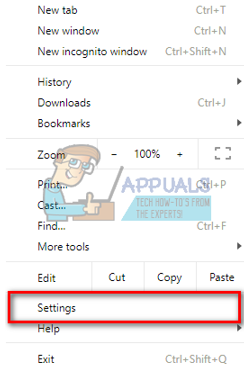
- Once the Settings page is opened, type “proxy” in the search dialogue bar present on the top.
- From search results, select the result which says “open proxy settings”.
- When the settings are opened, click on “LAN Settings” in the Connections tab, present in the bottom.
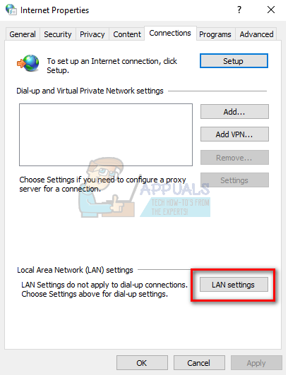
- Uncheck the line which says “Automatically detect settings”. Save changes and exit. Restart Steam.

Method 2: Through Network Settings
- Press Windows + R button to bring up the Run application.
- In the dialogue box, type “inetcpl.cpl”.

- The internet properties will open. Navigate to the Connections tab and click on LAN settings.
- Once in the LAN settings, uncheck the line which says “Automatically detect settings”. Save changes and exit to re-launch Steam.
With luck, the delay whenever you load a web page will disappear and the browser + the loading will become faster. If you encounter any sort of connection problem, you can always check the settings again for it to work.
Tip 2: Increase Steam’s Download Speed
Steam is preconfigured to automatically set the download region nearest to you as your default download region. However, it isn’t the ideal choice most of the time. There are many factors which you have to keep into account such as the server’s traffic status, the number of people it is accommodating, or the number of sales it is processing etc.
We can easily change your download server to ensure that you get faster speed while downloading any game.
The Steam content system is divided into different regions. The client automatically detects your region through your network and sets it as default. Sometimes, servers in a specific region may be overloaded or may be going through a hardware failure. Therefore changing the download region may help your Steam experience get faster. It is not necessary to change the download region only one time, you should try changing it to a couple of different locations. Also, try setting the download region to some place either in your nearby region or someplace far away.
- Open Steam and click ‘Settings’ on the drop down menu in the upper left corner of the window.
- Select ‘Downloads’ and navigate to ‘Download Region’.
- Select other regions other than your own and restart Steam.
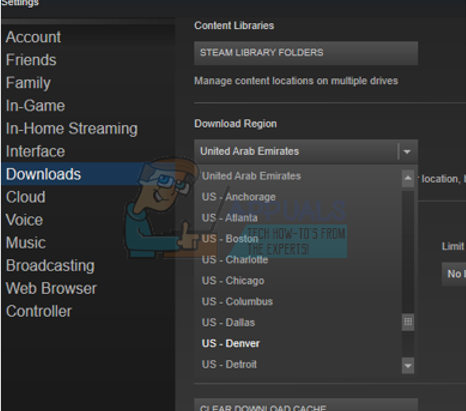
You may want to restart Steam in order to see the effects that took place. Sometimes, the server closest isn’t always the fastest. Try setting the region to somewhere away from your geographical location.
The load a server is undergoing isn’t visible right away to you. Steam provides the details about all servers. You can check their real-time status from here. Try looking up for alternatives and set them accordingly.
Tip 3: Accelerate your installed games and Steam
One of the best ways to accelerate your Steam client and the games you play is to get an SSD (Solid State Drive) and install Steam into it. Steam has the feature which allows you to move the game files from its default location to another hard drive. After moving the files, you can launch Steam.exe and it will launch like never even happened.
Steam also has the feature where you can configure multiple game library folders. That means you can install Steam on the hard drive and place all the game content on the SSD. Or vice versa. You can install the most played games on the SSD so you have maximum performance and the less played games on the regular hard drive.
To set up additional library folder, follow the steps below.
- Launch your Steam client. After launching, click on Steam present on the top left side of the screen. From the drop-down menu, select the option of Settings.
- Once you are in the Settings, navigate to the Download tab present at the left side of the screen. Here will see a button named “Steam Library Folders”. Click it.
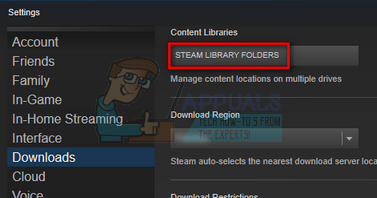
- Once in the Steam library folders, click on “Add Library Folder”. Now you can create a new game library on another hard drive.
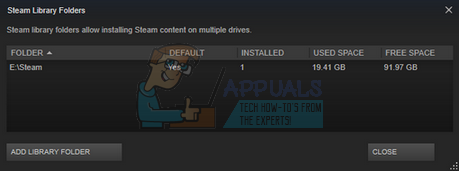
- The next time you want to install a game, you can choose the library folder you want to install it on.






